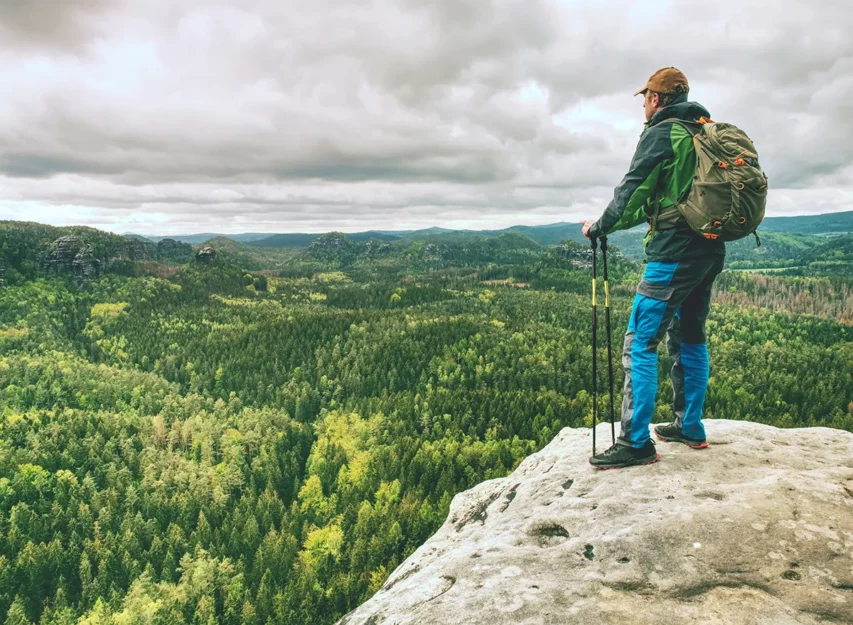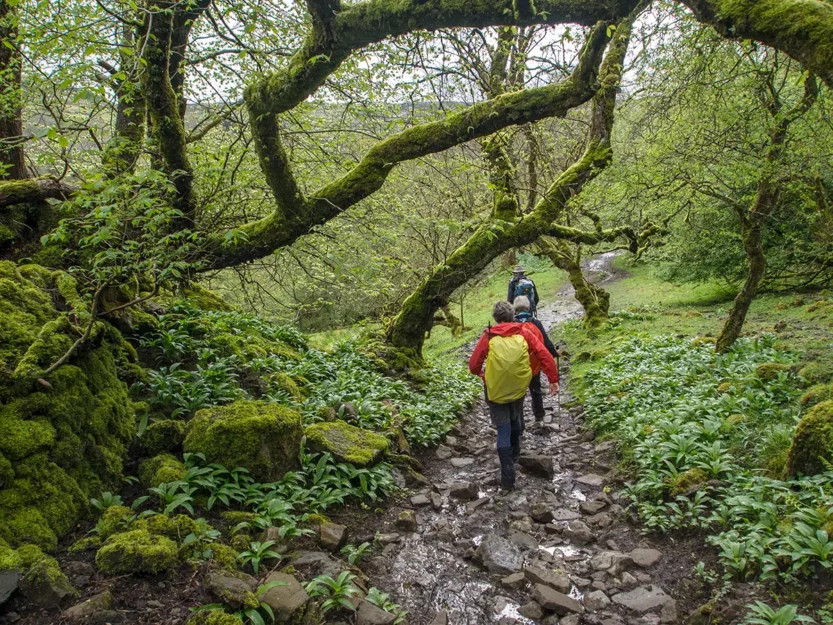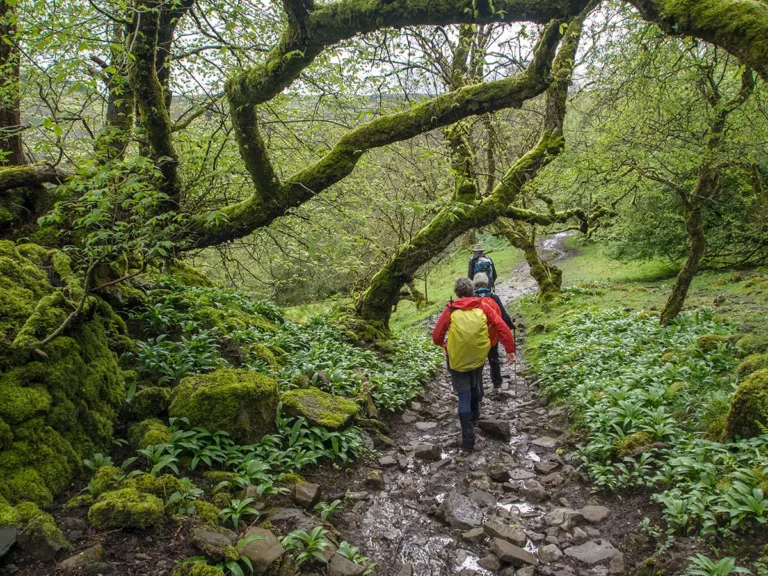I view hunting and hiking boots like off-road vehicles. I drive a Ford Raptor, built for speeding across rugged terrain. The 35″ bogger tires devour rocks, dirt, and mud at high speeds through back roads — but I struggle on the tight rocky trails my friends with Jeep Wranglers love to climb.
Hiking boots are the nimble jeeps of the boot world. Perfect for navigating rocky maintained trails. Hunting boots carry you off the road less traveled, protecting your feet along the way from dense woods, tough terrain, and weather.
Hiking and hunting boots are not the same.
This article compares the five hunting boots vs. hiking boots differences you have to know while shopping for a pair (plus one bonus answer). By the end, you’ll know which boot best fits your outdoor needs.
Hunting vs. hiking boots
The primary elements of hunting and hiking boots are the same. The differences lie in the type of construction. The core anatomy of boots includes the following:

- Upper: The main outer construction, uppers can range from ankle length to sixteen-inch snake boots.
- Midsole: A cushioned layer that helps shock absorption and impact on rugged trails.
- Shank: The shank sits between the midsole and outsole. It’s a stiff material typically made of metal or a composite that stabilizes the boot.
- Toe cap: A rubber guard for tow and boot protection. Toe caps can be internal or external
- Rand: Sitting behind an outer toe cap, the rand is another layer of protection to extend the life of a boot.
- Eyelets: Small reinforced hooks for customizing the lace placement on boots.
- Outsole: The bottom of the boot. Outsoles are strong, rugged synthetic rubber to prevent slipping and protect feet on hikes.
- Insulation: Keeps heat in and cold out. Insulated boots are best for weather below 50 degrees, with thicker insulation withstanding extreme cold temperatures.
The purpose of hunting boots
Hunting terrain is unpredictable. A trail doesn’t guide you to the Elk that ran 1500 feet down a thick brush mountainside — making a trek through thick brush, jagged rocks, and harsh elements common.
Hunters require boots with a sturdy, protective upper and a burly outsole. Preferably with waterproof qualities.
Even when not fowl hunting around water, the best hunting usually starts early, and the morning dew on grass and bushes will soak any piece of clothing not protected by a waterproof layer.
When hunting, hiking a few miles to find game is typical, and several trips back to camp to pack out a bull elk demand a comfortable shoe, so padding is essential.


Why hiking boots exist
When hiking, you rarely wander off-trail. Even Mount Whitney, the tallest peak in the lower 48 and one of the most demanding hiking trails in the U.S., is on a clear, well-traveled trail.
Because of this, hiking boots can be more flexible and are better designed for speed, comfort, and agility, than protection.
Not all hikes are a walk in the park, so hiking boots offer plenty of variety, including waterproof, mid-rise, and even insulated.
5 Hunting vs. Hiking Boots Differences
Hunting and hiking boots are tough, rugged, and protective, but each element’s construction separates the two.
Here are the significant differences between hunting and hiking boots.

1. Hunting boots have higher, more protective uppers.
When shopping for hiking boots, most uppers are ankle length or mid, rising slightly above the ankle. These lengths provide ankle support for rugged, challenging terrain or comfort and flexibility on more leisurely trails.
Hunting boot uppers typically range in size between 8-inch mid and 16-inch snake boots.
When trekking through dense forests, your next step is never a guarantee. It only takes one step into a leaf-covered hole to injure an ankle, ending your hunting trip early.
You probably made a wrong turn if you’re on a hike and find yourself in snake-infested waters. But it’s not out of the question when hunting fowl. That’s when a 16-inch waterproof snake boot is clutch.
2. Hunting boots are often waterproof
You never know where a hunt takes you. And even when avoiding creeks and rain, an early morning wake-up still involves dew-covered grass and bushes.
Hunting boots are almost exclusively waterproof, with lightweight hunting boots offering GORE-TEX breathable membranes.
Hiking boots can be waterproof, but many are water resistant. Protecting you from light rains and low flowing creeks but not stepping ankle deep in water.
As your hiking journey progresses, having multiple types of hiking boots is common. A high-ankle upper with waterproof construction for trails with creek crossings or hiking unpredictable game trails is essential.
Wet shoes and socks are a guaranteed way to send you back down the trail and home early.
3. Hiking boots are lighter and more flexible
When you don’t require the added protection of a hunting boot, you benefit from lightweight blends of suede leather and mesh. But full leather is still a very popular option for hikers.
Hiking boot materials are thoughtfully chosen with weight and flexibility in mind. A cell foam midsole of Ethylene-Vinyl Acetate (EVA) — the material used in exercise mats and athletic shoes — is typical in hiking boots.
With lighter materials, no insulation, smaller lugs, and a composite shank, the weight of hiking boots can be reduced considerably versus hunting boots.
The top-rated Merrell MOAB 2 hiking boot weighs 1 pound 15 ounces per pair, while Cabela’s Iron Ridge GORE-TEX hunting boots weigh 3.9 pounds, twice as much.

4. Hiking boots have less insulation
Cold fronts bring the deer out, and hiking or waiting in the extreme cold requires well-insulated boots. You can end a hiking trip early when the storm clouds roll in, but hunts are typically just getting started.
Many hunting boots insulate with 3M™ Thinsulate™ and range from 200 grams of insulation to 1400 grams. 3M Thinsulate is breathable, lightweight, odor and water-resistant, and made from 60% recycled materials.
When choosing insulated boots, 800 grams of insulation is best when temperatures are below freezing, while 200 grams are best for temperatures between 32 and 40 degrees.
Most insulated hiking boots are hybrid hiking hunting boots.
5. Hiking boots are better ventilated
Without the need for waterproofing, you’ll find many hiking boots have an upper mesh construction protected by suede leather.
Mesh allows the feet to breathe, which is essential on hot days or long hikes. Mesh and leather upper construction provide more flexibility and mobility but less protection from cold weather or rain.
Bonus: Hunting boots use camouflage
I’ll admit it; I love camouflage. I have camo cross-trainers, flip-flops, and crocs. And If I found a pair, my hiking boots would be camo too.
But my camouflage gear serves no purpose but looks.
When hunting, blending into the surroundings is essential. Since long pants and high brush cover most of a boot, it’s not always necessary, but camouflage is a distinguishable feature when shopping for boots.
Hiking boots range in colors and materials; some even have bright reflective accents. But the majority of hiking boots are brown or grey.
Final thoughts
Although the anatomy is the same, the difference between hunting vs. hiking boots comes down to the more robust construction of a hunting boot.
Hunting boots are perfect for the most demanding terrain and weather, with waterproof material, thick insulation, and high, supportive uppers, whereas hiking boots are best on the trail.
If you’re heading out for a hunt and searching for a hybrid option, hiking hunting boot hybrids do exist. These boots feature a mid-upper and are waterproof.
My grandmother always told me to care for my feet and teeth. It’s easy to take your feet for granted until you’re 3-miles out with aching arches and wet, numb toes.
Are you confident in choosing hunting vs. hiking boots? Share this article on social media to help others make the right footwear decision for their next outing.








